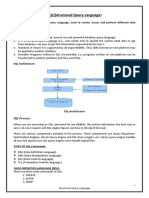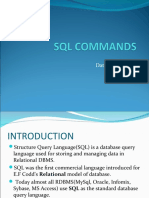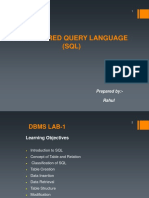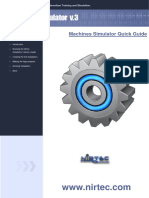BMS Institute of Technology and Management: Department of Master of Computer Applications
Uploaded by
Rupak DuttaBMS Institute of Technology and Management: Department of Master of Computer Applications
Uploaded by
Rupak DuttaBMS Institute of Technology and Management
(Affiliated to VTU)
Post Box No. 6443, Doddaballapura Main Road, Yelahanka, Bengaluru – 560 064.
Department of Master of Computer Applications
(Accredited by NBA, New Delhi)
DBMS Laboratory - SQL Basics
SQL – Structured Query Language – provides an interface to the relational database system. It is
developed by IBM in 1970s.
Components of SQL
1. DDL: Data Definition Language – is a set of SQL commands used to create, modify, delete the
database structure but not the data.
DDL Commands
1. Create – Creates the objects in the database
2. Alter – Alters the structure of the database
3. Drop – Deletes the objects from the database
4. Truncate – Remove all the records from the table including all the spaces allocated for record.
5. Grant – Give the users access privileges to the database.
6. Revoke – Withdraw the access privileges
2. DML: Data Manipulation Language is a set of SQL commands that allows changing the data within
the database.
DML Commands
1. Insert – Insert data into the table
2. Update – Update the existing data within the table
3. Delete – Delete all the records from the table, the space allocated remains
DCL Commands
1. Commit – Save the work done
2. Savepoint – Identify the point in a transaction
3. Rollback – Restore the database to the original position since the last commit
DQL Commands – Data Query Language
1. Select – Retrieves the data from the database
Creation of a table
Syntax: create table <tablename> (<col-name1><datatype>(size), <col-name2><datatype>(size));
Dr. Aparna K, Assoc. Prof, Dept. of MCA, BMSIT&M Page 1
Insertion of data
Syntax1: insert into <tablename>(col-name1, col-name2) values (expr1, expr2,…. , exprn);
Syntax2: insert into <tablename> values (‘&colname1’, ‘&colname2’, …. , ‘&colname-n’);
Select command
1. To select all columns and selected rows
select * from <tablename> where <condition>;
2. To select all rows and selected columns
select <colname1, colname2,…> from <tablename>;
3. To select all rows and all columns
select * from <tablename>;
Eliminate the duplicate data
A table can hold duplicate rows. In such a case, to view only unique rows, the distinct keyword can
be used with the select statement. Distinct clause allows removing duplicate from the result set.
Syntax: select distinct <colname> from <tablename>;
Sort the data
Ascending order: select * from <tablename> order by <col-name>;
Descending order: select * from <tablename> order by <col-name> desc;
Delete the data
1. All rows: delete * from <tablename>;
2. Selected rows: delete * from <tablename> where <condition>;
Add column to the existing table
Syntax: alter table <tablename> add (<new col name> <datatype>(size));
Drop column of the existing table
Syntax: alter table <tablename> drop column <col-name>;
Add values to the new column
Syntax: update <tablename> set <col-name> = ‘expr’ where <condition>;
Truncate the table
Syntax: truncate table <tablename>;
Add primary key to the existing table
Syntax: alter table <tablename> add primary key (col-name);
Drop the table
Syntax: drop table <tablename>;
Dr. Aparna K, Assoc. Prof, Dept. of MCA, BMSIT&M Page 2
Modify the size of the table
Syntax: alter table <tablename> modify (col-name datatype(size));
Rename the table
Syntax: rename <old tablename> to <new tablename>;
Logical Operators
1. AND – select <col-name1, col-name2> from <tablename> where <cond1> and <cond2>;
2. OR – select <col-name1, col-name2> from <tablename> where <cond1> or <cond2>;
3. NOT – select * from <tablename> where not (cond1 or cond2);
Range searching
1. Between – select <colname1, colname2> from <tablename> where <colname1> between ‘expr1’
and ‘expr2’;
2. select <colname1, colname2> from <tablename> where <colname1> not between ‘expr1’ and
‘expr2’;
Pattern matching
The like predicate allows for comparison of one string value with the other string value, which is not
identical. This is achieved by using wild card characters % and _
% sign – select * from <tablename> where <colname> like ‘2%’; -------------------------Example
_ sign – select * from <tablename> where color like ‘_ _ _ e%; ---------------------------Example
Aggregate functions
1. avg(n) – select avg (<colname>) from <tablename>;
2. min(n) - select min (<colname>) from <tablename>;
3. max(n) - select max (<colname>) from <tablename>;
4. count(expr) – select count (<colname>) from <tablename>;
5. sum(expr) - select sum (<colname>) from <tablename>;
Numeric functions
1. abs(n) – select abs(-15) from dual;
2. power(m,n) – select power(4, 4) as power from dual;
3. round (n,[m]) – select round(23.765) from dual;
4. sqrt(n) – select sqrt(36) from dual;
String functions
1. lower(char) – select lower(‘XYZ’) from dual;
2. initcap(char) – select initcap(‘lab’) from dual;
3. upper(char) – select upper(‘dbms’) from dual;
4. length(char) – select length(‘dbms’) from dual;
5. substr(char,m,[n]) – select substr(‘woman’, 3,5) from dual;
6. ltrim(char, [set]) – select ltrim (‘bread’, ‘b’) from dual;
Dr. Aparna K, Assoc. Prof, Dept. of MCA, BMSIT&M Page 3
7. rtrim(char, [set]) – select rtrim(‘sweety’, ‘y’) from dual;
8. lpad(char1,n,[char2]) – select lpad(‘sweet’, 9, ‘sour’) from dual;
9. rpad(char1, n, [char2]) – select rpad(‘sweet’, 9, ‘sour’) from dual;
To remove primary key from the existing table
Syntax: alter table <tablename> drop primary key;
Dr. Aparna K, Assoc. Prof, Dept. of MCA, BMSIT&M Page 4
You might also like
- OWASP Top 10 Threats and Mitigations Exam - Multiple Select - OWASPNo ratings yetOWASP Top 10 Threats and Mitigations Exam - Multiple Select - OWASP9 pages
- Unit-4_Introduction to Structured Query LanguageNo ratings yetUnit-4_Introduction to Structured Query Language96 pages
- EX - NO:1a Data Definition Languages (DDL) Commands of Base Tables and Views100% (1)EX - NO:1a Data Definition Languages (DDL) Commands of Base Tables and Views44 pages
- SQL Commands: A Data Type Defines What Kind of Value A Column Can ContainNo ratings yetSQL Commands: A Data Type Defines What Kind of Value A Column Can Contain12 pages
- Structure Query Language: by Prof - Manikandan QMC College, MedavakkamNo ratings yetStructure Query Language: by Prof - Manikandan QMC College, Medavakkam20 pages
- RDBMS-Day3: - Basic DDL Statements - DML Statements - Aggregate FunctionsNo ratings yetRDBMS-Day3: - Basic DDL Statements - DML Statements - Aggregate Functions61 pages
- WSE2007 ELA AP2023246000731 2024-01-23 Reference-Material-INo ratings yetWSE2007 ELA AP2023246000731 2024-01-23 Reference-Material-I38 pages
- Structured Query Language (SQL) : Prepared By:-RahulNo ratings yetStructured Query Language (SQL) : Prepared By:-Rahul79 pages
- Cassandra Query Language by Examples - Puzzles with AnswersFrom EverandCassandra Query Language by Examples - Puzzles with AnswersNo ratings yet
- M.M Rishad-Unit-01 Programming AssignmentNo ratings yetM.M Rishad-Unit-01 Programming Assignment30 pages
- EE: 451 Mobile Communications: Syed Ali HassanNo ratings yetEE: 451 Mobile Communications: Syed Ali Hassan38 pages
- 11 Class Computer Chapter 4 (SHORT QUESTIONS)No ratings yet11 Class Computer Chapter 4 (SHORT QUESTIONS)5 pages
- 01 Exercises-Functional-Mockup-InterfaceNo ratings yet01 Exercises-Functional-Mockup-Interface25 pages
- AN0353 Backing Up Critical Drive Setup Information Using CTSoftNo ratings yetAN0353 Backing Up Critical Drive Setup Information Using CTSoft12 pages
- Anant: Software Based Unified Communication ServerNo ratings yetAnant: Software Based Unified Communication Server24 pages

























































































